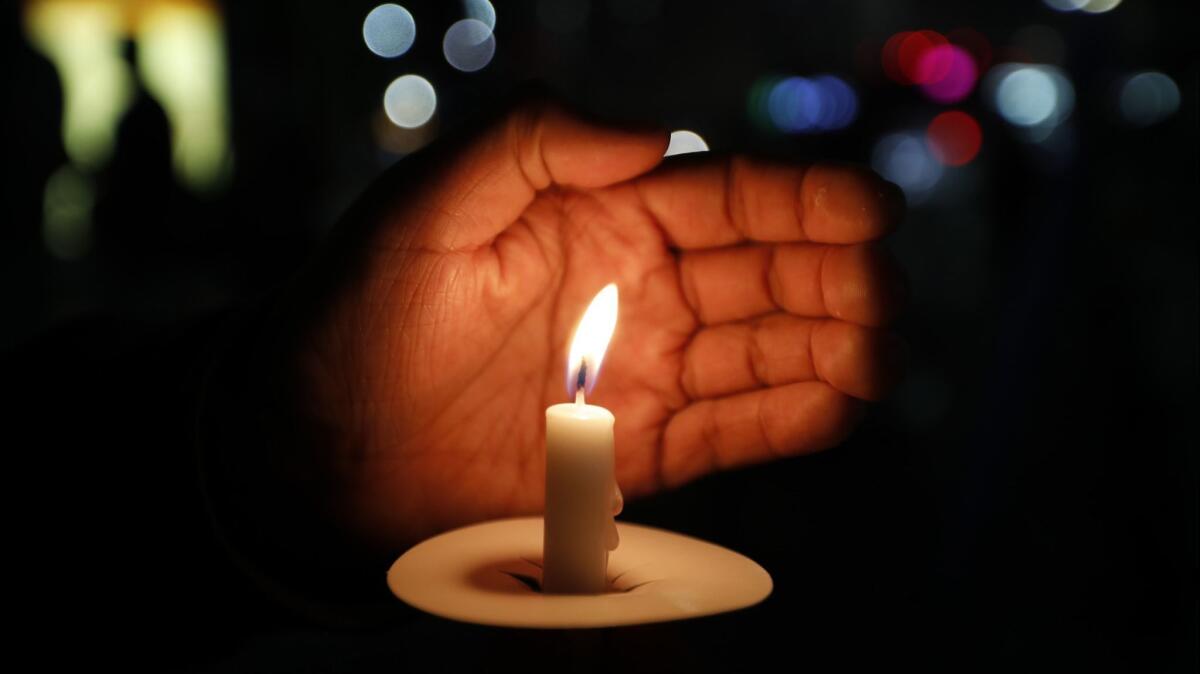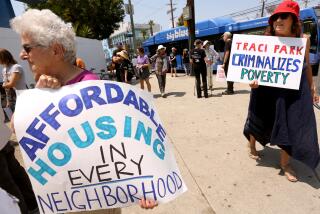Op-Ed: Making homelessness a crime is no way for Los Angeles to fix its crisis

- Share via
A week ago, the Los Angeles City Council adjourned in honor of Joe, a 56-year-old man who died in late August after spending five months living in a tent in Koreatown, near the apartment he had been evicted from earlier this year. It was a somber moment — a moment of recognition for one of the hundreds of people who die on the streets while homeless every year.
It was also a recognition that L.A.’s progress toward building housing had come too late for Joe, and that it would be too late for far too many others. But what was missing was an acknowledgement that, in the same chambers where Joe’s life was honored, the City Council has repeatedly passed laws that made Joe a criminal because he had no place to go other than the street.
I met Joe at a presentation I did in Koreatown on the criminalization of homelessness. He told the gathering about his experiences with the Los Angeles Police Department. He had lost all of his belongings in one of the countless sweeps of homeless encampments that take place every day in L.A. He just didn’t see a posted notice announcing the cleanup. He left his property for the morning, and when he came back, it had been thrown away.
The reality is that people will be living in tents on our streets for years to come.
In the weeks before he died, Joe was caught up in more than one of these sweeps. The city justifies its actions in part by pointing out that people who are homeless are breaking the law. And they are right. Every day Joe lived on the streets of Los Angeles, he was breaking any number of laws that criminalize homelessness.
When I visited Joe in Koreatown, he was in violation of city ordinances at least five times over. His makeshift shelter, which replaced the tent that had been taken by LA Sanitation the month before, was unlawfully tied to a nearby tree. It was impermissibly up during the day, to provide some relief from the 90-degree heat. He had a cart to carry his belongings — a forbidden “bulky item” —and it looked like he had more than would fit in a 60-gallon trash can, the amount allowed by law.
Each of these actions is prohibited by Los Angeles Municipal Code Section 56.11. And as we sat on the sidewalk and talked about his experiences, we were both in violation of Municipal Code Section 41.18(d), which outlaws sitting, sleeping and lying on the sidewalk.
Joe had set himself up within a short distance of the city’s proposed Koreatown “bridge housing” shelter for the homeless. As he honored Joe last week, Council President Herb Wesson told the crowd at the City Council meeting that had Joe survived, he would have been one of the first to get a bed in the shelter, which is part of the mayor’s attempt — a program called A Bridge Home — to put up a new temporary shelter in every council district.
I don’t know if Joe would have been one of the few people admitted to the new Koreatown shelter. I do know the mayor is also promising increased enforcement of laws like Municipal Code 56.11 and 41.18(d) around the bridge shelters, to placate neighbors who oppose them. So if Joe had not gotten a bed, he likely would have been subjected to that increased enforcement: weekly sweeps and daily harassment intended to drive him from the neighborhood where he had lived for more than a decade and where he had a support system.
Enter the Fray: First takes on the news of the minute from L.A. Times Opinion »
I was in the City Council Chambers in 2015 and 2016 when the ordinance that limits the amount of property the homeless can have was debated and passed, and when “dwelling” was prohibited in vehicles on most L.A. streets. The council members’ discussions focused almost solely on addressing the visible signs of homelessness — tents, sleeping bags, cars — rather than the needs and lived experiences of the people whose existence they were about to regulate. For every encampment swept away or car towed based on those ordinances, there is a person who relied on that tent or car to survive.
Over the past few years, L.A.’s elected officials have finally begun to acknowledge that people are homeless because of decades of failed policies, because the city is plagued by an affordable housing crisis, because there are simply not enough homes here for the nearly 23,000 people who are unsheltered every night. A Bridge Home opened its first shelter, at El Pueblo, three days after the City Council recognized Joe’s death. If every bed proposed for the program were available tomorrow, there would still be more than 20,000 too few beds to accommodate every homeless person in L.A.The reality is that people will be living in tents on our streets for years to come.
It does not honor Joe for the City Council to, on the one hand, recognize his death — and how the city failed him — and, on the other, to continue to invest in policing and sanitation strategies that treat encampments like trash and punish people simply for being homeless.
Shayla R. Myers is an attorney at the Legal Aid Foundation of Los Angeles.
Follow the Opinion section on Twitter @latimesopinion and Facebook
More to Read
A cure for the common opinion
Get thought-provoking perspectives with our weekly newsletter.
You may occasionally receive promotional content from the Los Angeles Times.









